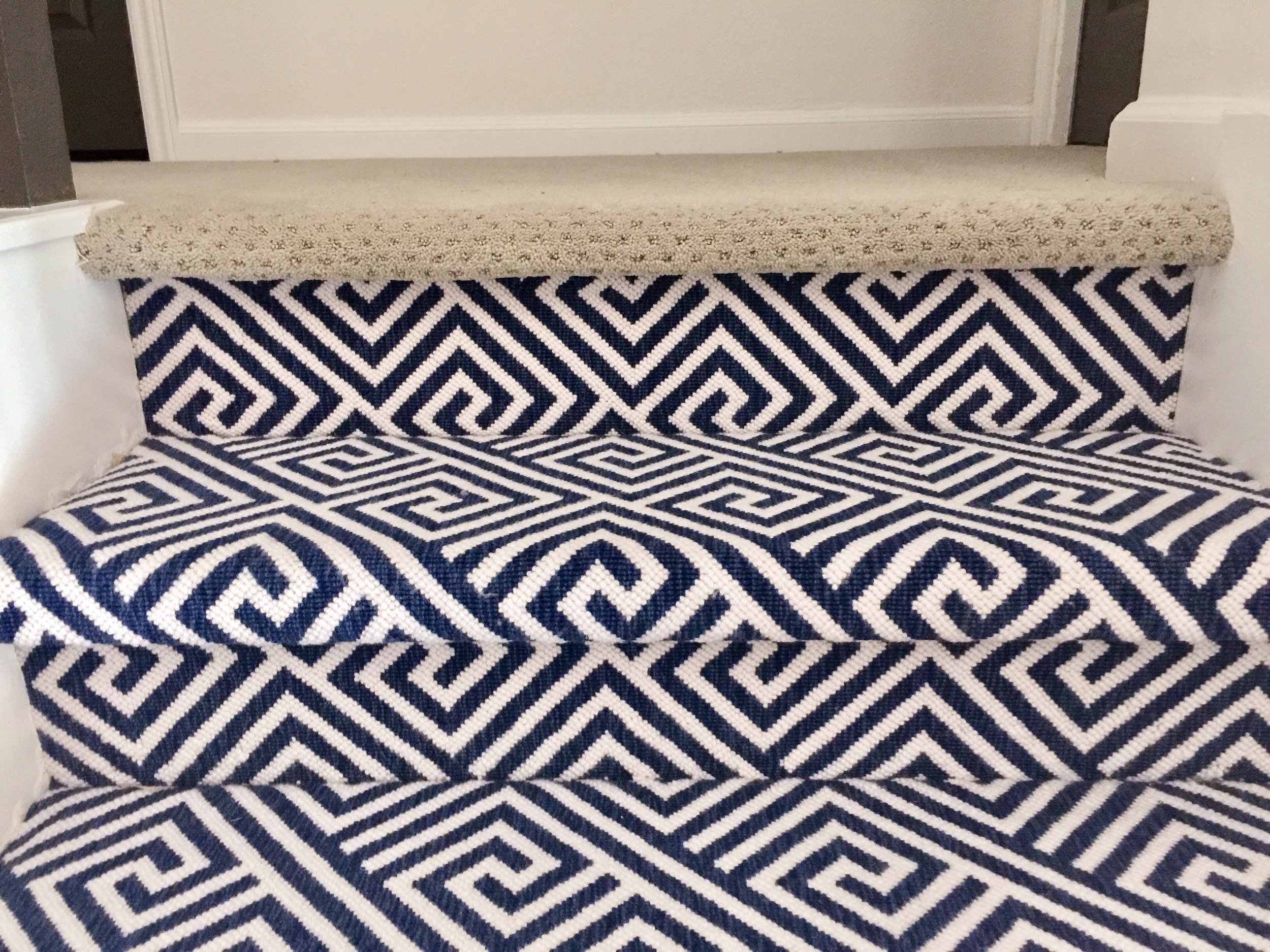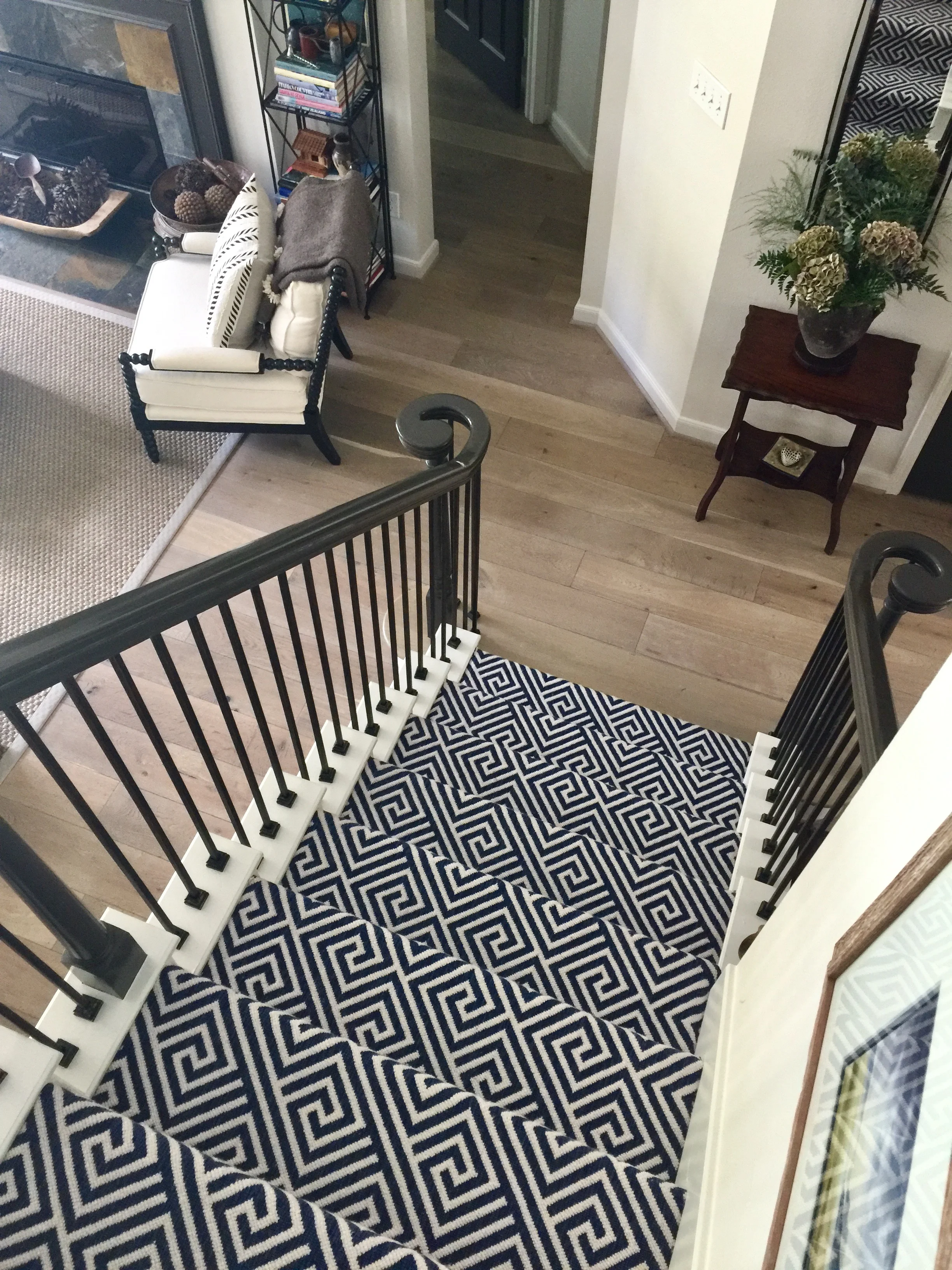"Should I carpet my stairs with the same carpet I use upstairs?"
This was basically the question that a reader asked on this post about choosing flooring for an open plan house.
5 Tips For Choosing Flooring For An Open Plan House
She was applying my general design rule of thumb, of either having your flooring be all the same in an open plan house, or blending the different products in color and value, so that the concept of the open plan isn't chopped up by contrasts in flooring.
(This isn't necessarily desireable for very large, estate homes, where a change in flooring can create more intimate areas and more interesting individual spaces in these vast properties. My old post was addressing issues with flooring in homes that are smaller or more typical suburban builder homes, where the spaces are quite open to each other and transitioning flooring material is difficult to do without looking obvious or poorly designed.)
When it comes to stairs, however, we like to break up the visual.
We want something contrasting because really, a stair is a very noticeable architectural feature. We want it to stand out. Most times, stairs help create design style in a home and it is the perfect place to upgrade for some pattern and color.
It is actually a good place to invest in higher quality goods, because of the wear and tear it receives on the nosing and it will hide soil better too.
Going with a contrasting patterned carpet on a stair is kind of a less expensive way to achieve the "wood stair with a runner" look.
I did this, in fact, with my own stair, which is right in the middle of my open plan home, just beyond the entry hall.
Isn't that pattern great? :-) I love it and feel this was a nice upgrade in my home that contributes a lot to bringing in some color and pattern.
That pattern is from Stark by the way. Here's the link.
The remodel of my stair was done when we did my wood flooring. Previously, I had white painted, traditional balusters and a plush beige carpet. So, I had a wood tread installed at the bottom step (it adds a level of quality and creates a nice transition), plain iron balusters, painted the railing, and then added the patterned carpet.
Here are the stairs in progress.
You can see the bland, plush carpet here. It was constantly getting stained by the way. We had two dogs and two kids running up and down those stairs and the little dark spots that would appear bugged me sooooo much.
Wood tread going in on bottom step
New wood tread on first step in white oak
Wood step is in. Beige plush carpet is blech. :-)
New balusters will replace old painted wood.
Carpet transition at top of stairs
That pic above is how you transition the upstairs carpet to the stair. Not beautiful......but not that noticeable really. And it sure beats having that carpet up at the top run all the way down the stairs.
Always try to transition materials on an inside corner. It wins every time.
So, are you wondering why I didn't do wood all the way up and then install a runner? Well, because I didn't want to make that investment in this house. It would have been much more money, to the tune of thousands more, if I had done wood treads all the way up. Plus, if I needed a runner anyway, and I did for traction for the traffic on the stairs, then this was a good shortcut.
If I would have done wood treads, then when they took the balusters out, they would have laid the treads all the way across the steps and not done that trim. Yes, a nice, upgraded feature, but I had more remodeling to do and didn't want all my money in my stair.
It achieves what I wanted. A dynamic and interesting pattern, right in the middle of my open plan home, that introduces color and makes a statement. :-)
Patterned stair carpet in center of open plan home with wood bottom step - Designer Carla Aston #stairrunner
Here are some jobs of mine that had wood stairs, where we installed runners. I really love a runner on a stair. I love the way it can bring in pattern and color, help with safety and prevent slipping, and add some softness to big, hard surface feature in a home.
Especially if the risers are the same wood finish as the steps, I really love to see a runner.
Carpet runner on stair - Designer Carla Aston #stairrunner
Carpet runner on stair - Designer Carla Aston #stairrunner
Carpet runner on stair - Designer Carla Aston #stairrunner
Here's a job where I proposed a runner in a light color with a cross-hatch pattern to break up the big dark blob of a wood stair. The homeowner wanted a lighter, fresher look to her entry hall, and boy, would that carpet sure fix that issue.
Dark, stained wood stair
Proposed short, cut-pile carpet with cross-hatch pattern proposed for stair
Sketch showing new carpet runner on dark wood stair - Carla Aston, Designer
And here is another stair, below, on a job we did a few years ago. We just installed a new patterned carpet. Even in a beige neutral, it looks so much better. It looks intentionally designed with that pattern, rather than with the carpet from upstairs.
I like to use a short, dense pile, a loop carpet, or a combination loop/cut pile so that the stair carpet doesn't look "fluffy" or "puffy", but neatly trim and tight.
On this project, we did new wood flooring on the first floor and then stained the wood elements of the stair to match the new flooring product.
BEFORE - standard carpeting on stair
AFTER - Stair installed with patterned, low-pile carpet
AFTER - Stair installed with patterned, low pile carpet
Project with carpet designed to look like a runner
When it comes time to change out your carpeting and you have a stair that needs it too, don't just go with the same that you are putting in upstairs. Consider helping that stair stand out and make a statement, as well as going a long way to hide soil, wear and tear.
Need more flooring advice?
I've got you covered. CLICK HERE for more info on my downloadable pdf on the subject. :-)
Pin this post to Pinterest to save for reference later!




















